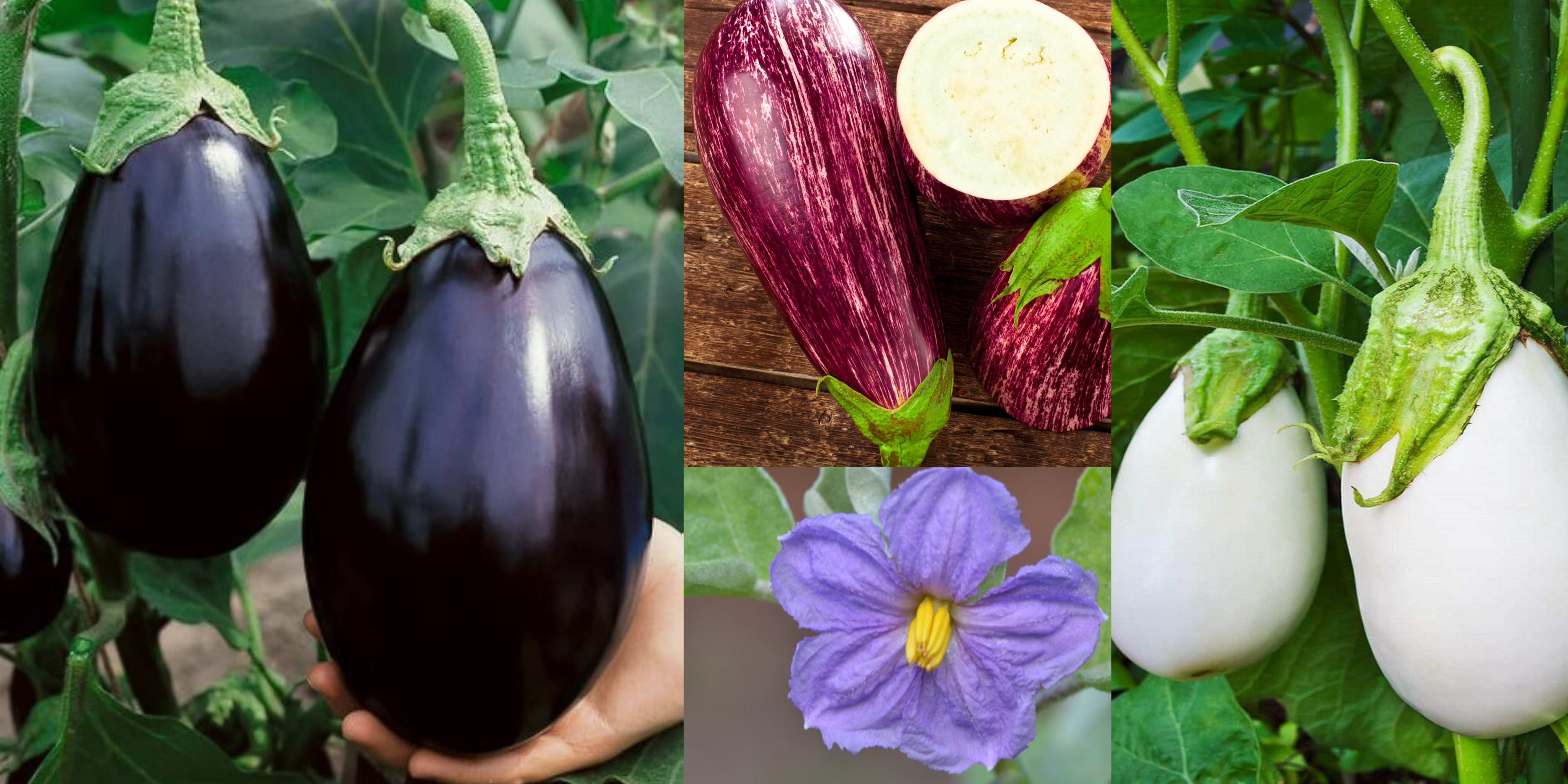Eggplant Research
Solanum melongena (Brinjal, Aubergine, Eggplant)
Background
Solanum melongena, more commonly known as brinjal or aubergine, is called eggplant domestically. Eggplants are a perennial plant domesticated from the tropics of Asia from the nightshade family (Solanum) which is frequently grown as an annual in the United States. Eggplant fruits are utilized as a component in human diets and exist as a key ingredient in dishes of Asian, Middle Eastern, and Mediterranean cuisine. While eggplants are not inherently high in nutritional content, their value comes from the spongy texture that allows for absorption of flavors during cooking.
Production of eggplant in the United States is conducted by over 7,000 operations and covers approximately over 5,000 acres; eggplant production exists as a diversified component of fresh market produce sales (USDA Agriculture Census, 2017). Many commercial eggplant farms are located in states with tropical to subtropical conditions (such as Florida, Georgia, and California); however, states such as Montana and neighboring North Dakota, South Dakota, and Wyoming have reported farm operations for fresh markets. In general, since the late 1990’s and early 2000’s, the price received for eggplants has increased from less than thirty cents per pound to over sixty cents per pound. Prices received at local farmers markets, as part of community supported agriculture, and through direct to restaurant sales can be considerably higher; however, distribution via these sales avenues requires a production plan and assessment of local market needs to ensure revenue from sales meets the required investments.
Production
Field production of eggplants is conducted similar to tomatoes and peppers, two of its Solanaceae familyrelatives. When grown as an annual plant, eggplants are started from seed in the greenhouse approximately 1-3 months prior to field planting. A typical eggplant production cycle is noted in Table 1. Transplants are planted into the field after the risk of spring frost and when soil temperatures generally exceed 60ºF. Plants are maintained for the next several months during which they are sometimes trained with simple stake-and-tape training systems. Harvest begins in late-July with full-harvest beginning in earnest during mid-August. Harvesting is conducted frequently to ensure continued flowering (for future fruits) and to capture fresh fruits that are mature and at their peak of dietary agreeableness (over-mature eggplants have altered coloration and take on undesirable characteristics such as excessive bitterness).
Weed control is most often provided by plasticulture, weed mats, or some other form of weed exclusion material that is recommended to reduce competition from the endemic weed seed of a field. Weed control can be supplemented with pre-emergent herbicide applications prior or through hand weeding as needed post-planting.
Eggplants require supplemental irrigation in western Montana’s growing conditions, this is achieved through drip tape placed beneath weed barriers. Insufficient watering may result in dry fruit while excess watering may result in root rot. If soil is not well drained or there is a history of root rots or wilt at the site, consider growing grafted eggplants. Grafted eggplants consist of a desirable fruit producing scion (top) grafted onto a resistant rootstock (bottom). The resistant rootstocks can be from S. melongena, close relatives S. aethiopicum and S. torvum, or even from tomato (S. lycopersicum). Rootstocks are used most frequently to provide resistance to bacterial (bacterial wilt) and fungal (Fusarium wilt and Verticillium wilt) soil borne diseases.
Table 1. Production timeline for eggplants in western Montana.
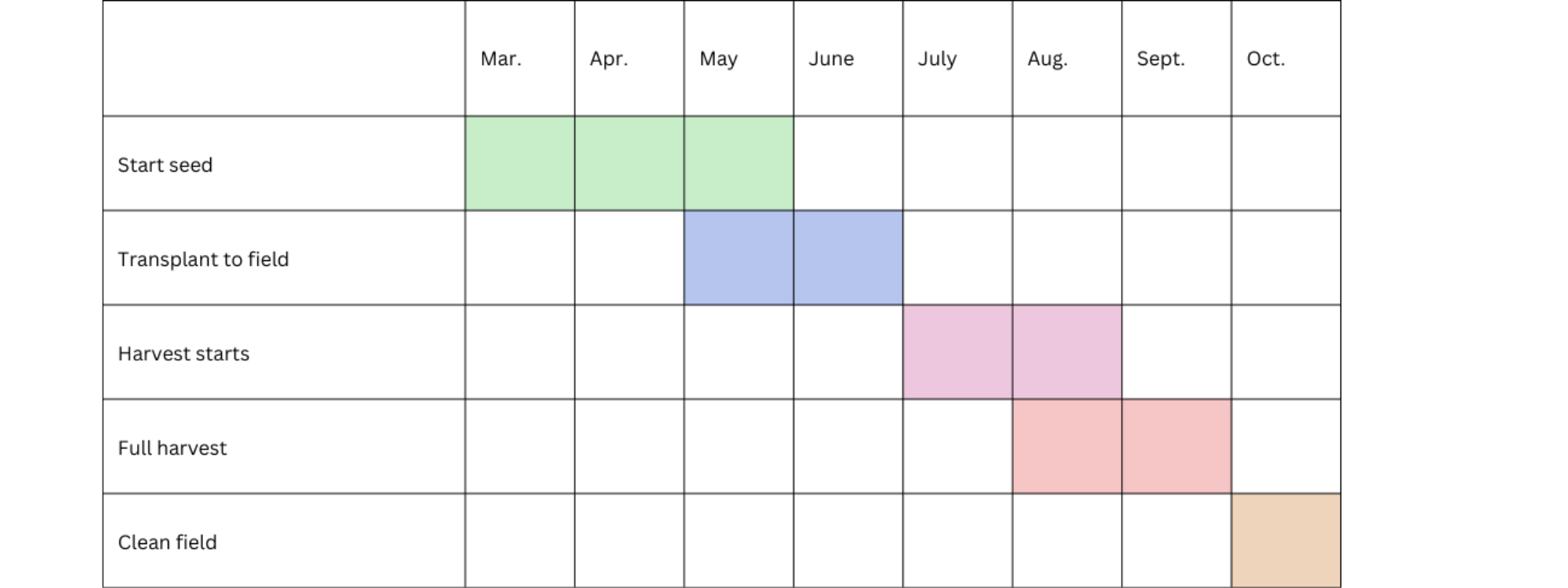
Experiment 1 (2022)
In 2022, researchers at Montana State University’s Western Agricultural Research Center initiated a preliminary evaluation of productivity for a diverse panel of 18 different eggplant lines, focusing primarily on Solanum melongena but also including the wild relative, S. aethiopicum (also known as bitter tomato, Ethiopian eggplant, pumpkin-on-a-stick). The plants sampled represented a multitude of market classes, colors, and shapes varying in their improvement status from open pollinated (OP) to hybrid (F1).
Single plant yield varied, but was generally below 1000 g per plant; the highest yielding plant, ‘Astakom’, produced 839.9 g (about 1.85 lb) (Table 2). The lowest yielding plant, ‘Patio Baby’ only produced 268.9 g (less than 0.60 lb). Two of the cylindrical genotypes (‘Fengyuan Purple’ and ‘Little Fingers’) produced the greatest number of fruit per plant (12.3 and 15.3, respectively). Regarding overall fruit size, only three varieties exceeded a mass of 100 g per fruit (‘Aswad’, ‘Edirne Purple Striped’, and ‘Listada de Gandia’).
Table 2. Yield characteristics of eggplant (Solanum melongena and S. aethiopicum) grown in field conditions at Western Agricultural Research Center near Corvallis, MT during the 2022 growing season.
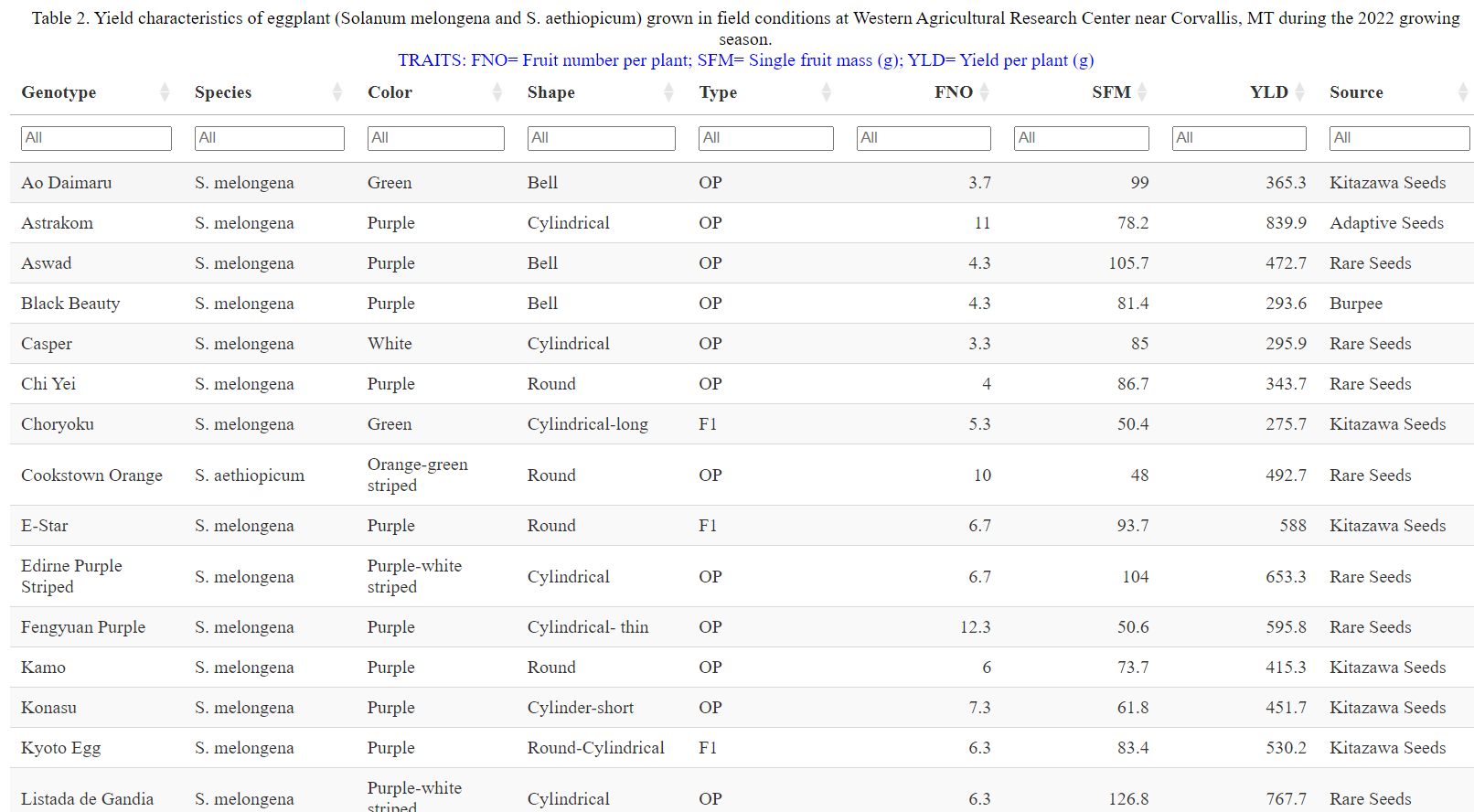
Yield is important to farmer revenue, but smaller eggplant fruits are not inherently bad for sales. Many of the fruit shapes, sizes, and colors evaluated during this assessment are not available in grocery stores where the typical selection is large, cylindrical to round purple eggplants. As a result, the many unique eggplants available to growers may have a benefit for local sales due to novelty (Fig. 1).
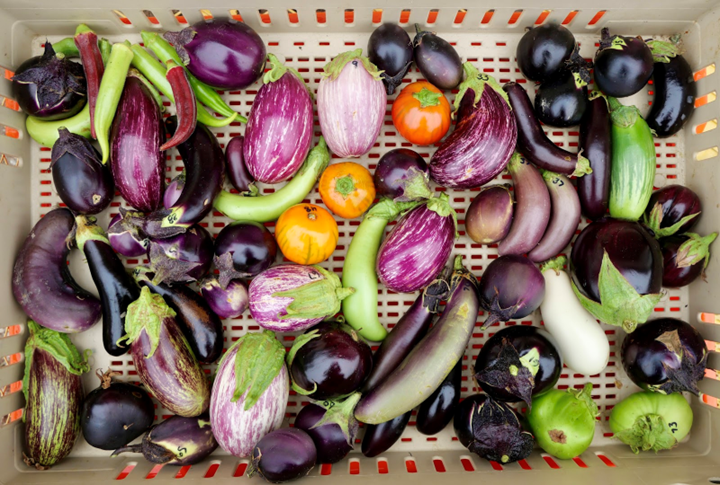
Figure 1. A diversity of eggplant (Solanum melongena) and Ethiopian eggplant (Solanum aethiopicum) shapes, sizes, and colors were evaluated during the 2022 screening. Note: Okra (Abelmoschus esculentus) of burgundy and green varieties are also tucked in the top-left corner of this eggplant fruit basket.
Experiment 2 (2023)
During the 2022 season, fruit of purple and green eggplants were well received, but fruit from white eggplant appeared more highly desired by workers for culinary purposes. As a result, in 2023, researchers at Montana State University’s Western Agricultural Research Center conducted a focused screening of white eggplant performance under high tunnel conditions using five different cultivars: ‘Arteussa’ (F1), ‘Casper’ (OP), ‘Gretel’ (F1), ‘Japanese White Egg’ (OP), and ‘Paloma’ (F1) (Fig. 2).

Figure 2. White eggplant (Solanum melongena) cultivars from left to right: ‘Arteussa’, ‘Casper’, ‘Gretel’, ‘Japanese White Egg’, and ‘Paloma’.
Of the white eggplants evaluated, all exceeded 1000 g in total yield except for ‘Japanese White Egg’ which only produced 824.3 g per plant (about 1.8 lb) (Table 3). ‘Paloma’ produced the greatest yield at 2462.6 g per plant (almost 5.5 lb). ‘Paloma’ also produced the largest fruit mass (269.6 g; about 0.6 lb). ‘Gretel’ produced the highest number of fruits (21.2 fruit) which were also the smallest mass (54.2 g; approximately 0.11 lb).
Table 3. Performance of white eggplant (Solanum melongena) in high tunnel conditions at Western Agricultural Research Center near Corvallis, MT during the 2023 growing season.
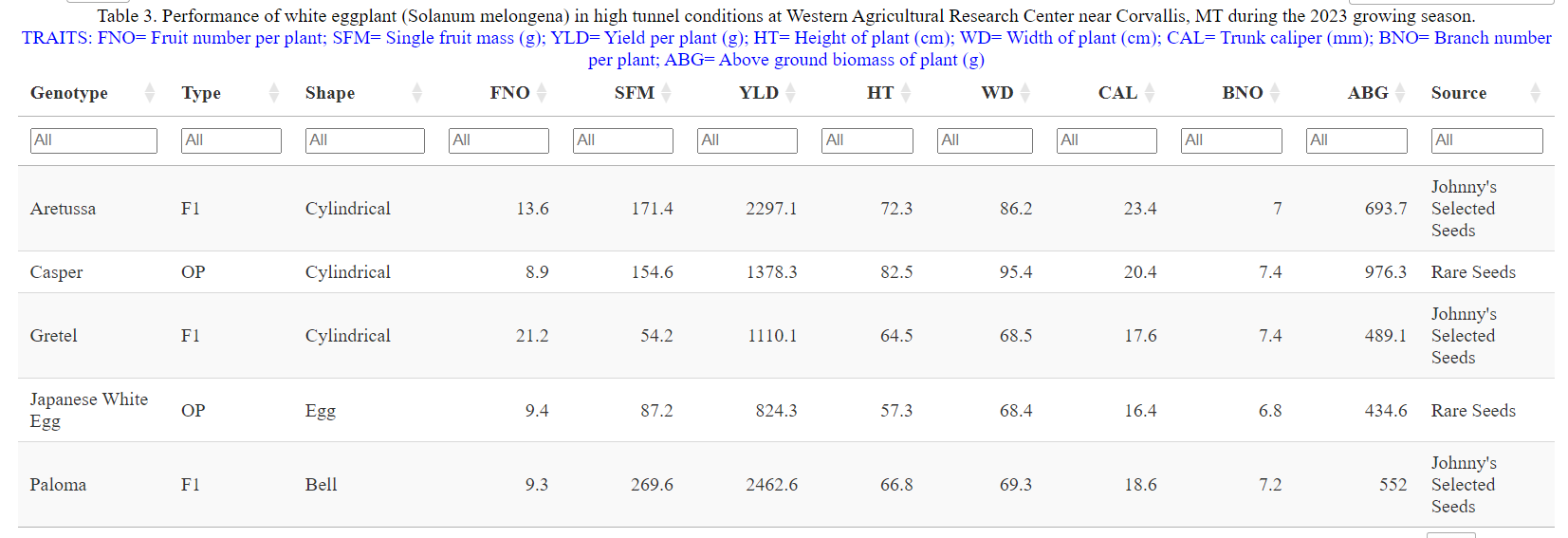
Overall notes
When assessing the value of specific truck crops, like specialty fruits and vegetables, it may be challenging to quantify the overall economic impact of having a unique crop for sale. In the case of eggplants, direct sales of the fruit may only reflect a portion of their overall effect on revenue for a farm. Crops that are unique and catch consumers’ eyes may bring value by encouraging greater foot traffic and conversations during local sales events.
For homeowners and subsistence plots, eggplants bring diversity to diets while offering unique color, shape, and flavor absorbing texture. Given minor care, they are relatively easy to grow and productive in both field and controlled conditions. For field grown eggplants in Montana, homeowners must consider the length of time until production starts and the brevity of the harvest period. Not unlike zucchini plants (Cucurbita pepo), just a few plants may provide more than a family can handle once harvest starts in earnest. Depending on the year’s growing conditions, western Montana homeowners can anticipate and plan recipes to highlight eggplants for about a one month period from mid-August until temperatures cool off and plants shut down in autumn.
Some production issues to consider
Fruit harvest and storage: Plan to sell or eat your eggplant shortly after harvest. Fruit quality is not easily maintained and eggplants are sensitive to bruising, scratching, and browning. They oxidize and their quality deteriorates rapidly. Eggplant fruit are not typically preserved via canning, but they can be dried and used in preparation of stuffed eggplants (known as kuru patlican dolmasi in Türkiye). Fresh eggplant fruit can be maintained for about a week when held at a cool temperature (~50 ºF). Eggplant fruit may experience chilling injury when refrigerated at colder temperatures.
Spider mites: Two-spotted spider mites (Tetranychus urticae) are a mite pest of eggplants. They can give leaves a scuffed appearance as they proceed through up to 20 generations within a year. They are readily visible on leaves, and easily confirmed with a magnifying lens. Conditions that encourage spider mite development include dry conditions, weedy fields, and excessive fertility. Spider mites can be reduced through overhead irrigation to wet the leaves of plants in dry conditions. Spider mites can be controlled with application of predatory mites or use of selective organic or conventional insecticides.
Verticillium wilt: Verticillium wilt, caused by Verticillium dahliae, forces symptoms such as yellow leaves, leaf rolling, and foliar wilting. Infection can stunt plants, reduce yield, and result in plant death. Verticillium wilt’s overwintering fruiting bodies (microsclerotia) are long lived, persisting for multiple years in the soil. This combined with the nature of verticillium wilt which infects many other valuable crop plants, impacts the rotation strategy. Broccolli and corn are two plants which are not known hosts, thus making suitable rotational crops.
Sunscald: Sunscald is an abiotic disorder in which fruit appears burnt, browned, or sunken. Fruit with sunscald is typically unsalable. Sunscald is triggered via exposure of fruits to abrupt, intense, direct solar radiation. Sunscald is likely to occur in fruit remaining following a harvest when extensive leaves or branches have been disturbed or removed as part of harvesting other fruits. This sudden exposure of fruit within the inner canopy which has minimal sun exposure prior can often result in symptoms of sunscald.
Leathery fruit: Insufficient moisture provided to the plant may result in dried, withering, leathery fruit. Rectify this issue by supplying more water at each irrigation event or increasing irrigation frequency.

